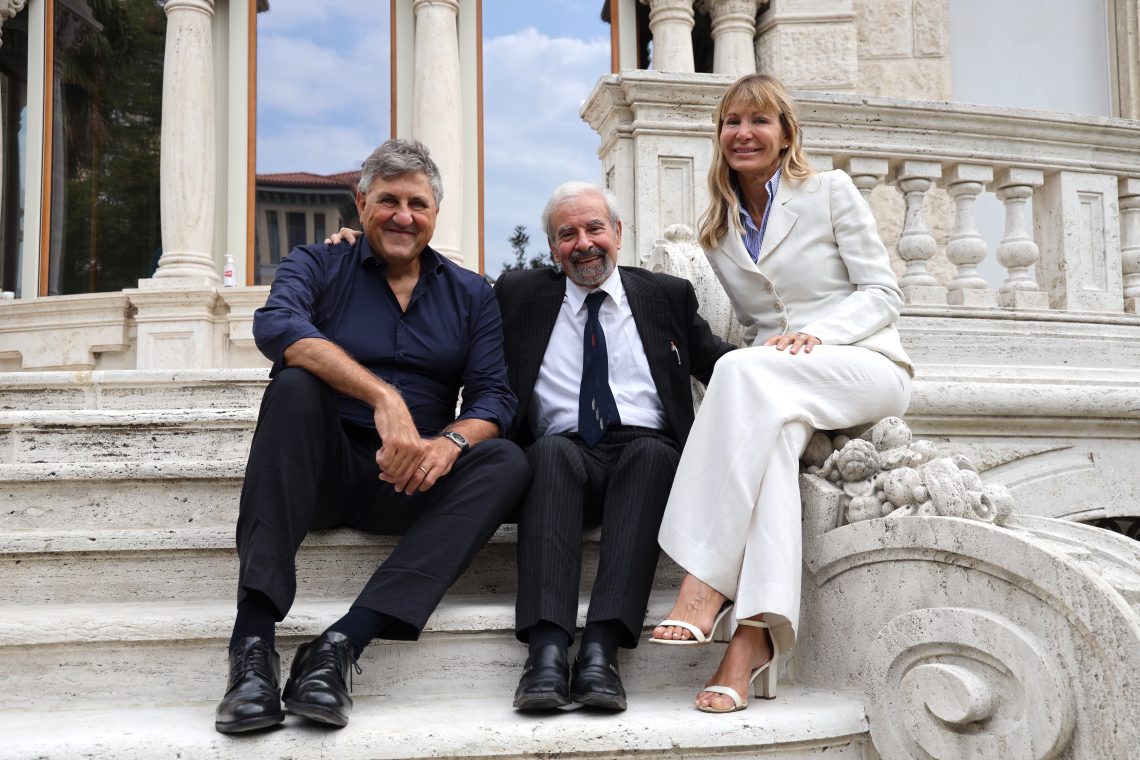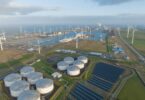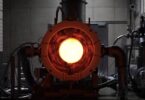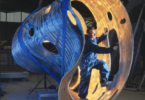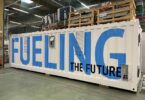As the global energy crisis escalates there is a growing need for the grid to have a stable, clean energy source to work together with hydro, wind, solar and other renewables to deliver uninterrupted electricity.
Ramping up nuclear energy is the natural choice if governments prioritize moving to more predictable long-term electricity prices and meeting their climate targets, argues Stefano Buono, CEO and co-founder of newcleo, a startup backed with €400 million in private capital, that aims to design and build the next generation of nuclear reactors.
Newcleo has 13 patents on a waste-to-energy reactor technology that can be used to produce energy and, at the same time, burn radioactive nuclear waste from existing nuclear plants that would otherwise be buried underground, ushering in a circular economy for the nuclear energy industry.
“Our innovative reactors will provide the world with a safe and stable green power source and reduce volumes of radioactive waste,” says Buono, an Italian nuclear physicist who started his career working with Nobel laureate Carlo Rubbia at the European Organization for Nuclear Research (CERN) and the Center for Advanced Studies, Research and Development in Sardinia (CRS4,) in the field of accelerator driven systems and nuclear waste transmutation.
While working as a researcher Buono and his colleagues devised ways to vastly improve on nuclear reactors, but but there was little interest when oil was $10 a barrel and no one was worried about Co2 emissions, he says. So, in 2002 Buono created a private company focused on nuclear medicine called Advanced Accelerator Applications which was listed on NASDAQ in 2015 until its acquisition by Novartis for $3.9 billion in 2018.
Now the time is ripe for him to invest some of his windfall and his energy into newcleo, says Buono. “I am ready, and the market is ready,” he says.
Forecasts by the Intergovernmental Panel on Climate Change, the International Energy Agency (IEA), and the International Atomic Energy Agency (IAEA) say if nations expect to be where they say they want to be on climate goals in the coming decades they will have to double nuclear energy capacity.
The last major energy crisis prompted the building of some 40% of today’s operating nuclear power plants. The upfront costs were considerable but today these plants supply some of the cheapest electricity in the world, says Buono. Technically, nuclear has the advantage of the atom’s high energy density, meaning it can supply uninterruptible energy at scale with a comparably minimal physical, as well as carbon, footprint; its fuel can be stored to avoid big price fluctuations or supply interruptions; and the physical size of its waste is small, he says.
Governments are taking note. For many countries, nuclear power in general and the kind of small modular reactors (SMRs) newcleo is developing in particular are a solution because they are potentially safer and, in principle, faster and cheaper to build than conventional nuclear reactors.
According to the International Atomic Energy Agency, there are currently about 70 SMR projects worldwide and a wide variety of designs and advanced technologies for so-called IV generation reactors are being studied. These include six categories: supercritical-water-cooled reactors, molten salt reactors, sodium-cooled fast reactors, very-high-temperature reactors, gas-cooled fast reactors and lead-cooled fast reactors (LFRs), which newcleo specializes in.
About 30 countries are actively considering, planning, or preparing to build new nuclear power plants, says Buono. France’s President, Emmanuel Macron, for example, has dedicated €1 billion to new nuclear projects. Newcleo is one of the projects being considered.
But Buono is not waiting for government action. Newcleo is progressing with plans to build a small demonstration reactor in Italy by 2026 and full-scale reactors of its own design in France by 2030 and in the UK by 2032. “These will be funded by private money,” says Buono. “If we can also have public funds, I will be very happy, but in the past I have suffered so much from not having the support of governments, that we are set up to do it alone.”
Building A New Generation Of Reactors
Reactor design has come a long way since the 1970s and 1980s, when accidents shook the public and undermined faith in the technology. In 1979, for example, a partial meltdown of the Three Mile Island reactor in Pennsylvania, was the most significant accident in U.S. commercial nuclear power plant history. The Chernobyl disaster, a nuclear accident that occurred in 1986 due to a reactor design flaw and human error at the Chernobyl Nuclear Power Plant, near the city of Pripyat in what was then the Soviet Union, led to deaths and health problems linked to radiation poisoning, further raising alarm about the safety of nuclear energy.
Buono and his colleagues at CERN began working on a way to make reactors safer in the 1990s. The idea of Rubbia, the Nobel laureate, was to build an accelerator-driven reactor, by coupling a sub-critical core with a particle accelerator. In this way, the fissile reaction would only be possible and completely controlled via the accelerator: by switching it off, the whole reaction would stop.
The Italian government invested billions of liras to create an industrial design with the help of Ansaldo Energia, an Italian power engineering company, and a private company in Spain separately tried to develop new reactors based on this breakthrough, but there was limited interest in developing the next generation of nuclear energy reactors at the time, says Buono.
A second breakthrough, involving the use of liquid lead as a coolant, was developed by Buono with the help of fellow researchers. Most nuclear power plants in operation today are cooled by water. This is risky because if hot uranium contacts water, it can react to form hydrogen. The steam pressures and/or the explosion of the hydrogen can rupture the reactor vessel and allow radioactive vapors to escape. In the Seventies France tried to replace water by using liquid sodium as a coolant (like in the Superphenix, a high profile nuclear power station prototype built on the Rhône river) , but it cost up to 60% more to build reactors with this design, so the idea was abandoned, says Buono.
Newcleo is taking a different approach. Unlike sodium which burns readily in air and can explode in contact with water, lead does not react significantly with water or air, allowing easier, cheaper, and safer containment, says Buono. Core cooling is done in a large pool of lead, which remains liquid until 1,700 degrees Celsius. If anything goes wrong the reactor would be stopped by physical phenomena and cooled by natural convection and operators would have days rather than hours to fix any problem without the risk of any damages, says Buono.
What’s more Newcleo’s lead-cooled fast reactors are fueled with mixed oxide fuel (MOX), which is composed of depleted uranium, a by-product of the enrichment process, and plutonium, extracted from spent fuel. Both have become a liability as they pile-up and find little to no use.
Newcleo’s reactors will produce only fission fragments as a final waste, meaning the long lived elements heavier than uranium like plutonium can be continuously recycled, says Buono. The advantages are that no new uranium need to be mined and newcleo’s Lead-cooled Fast Reactors (LFRs) make far more efficient use of fuel. Today reactors use only around 0.5% of the uranium extracted in mines, the rest is considered waste and the long lived elements heavier than uranium need to be stored in the geological deposit and this waste remains radioactive for thousands of years. The amount of nuclear left over by newcleo’s technology comes back to the natural radioactivity levels of the mines in 250 years and the company can use 100% of the power contained in the uranium, Buono says.
Nuclear reactors produce very limited volumes of waste in proportion to the amount of energy produced. IAEA studies show that assuming that nuclear waste is not reprocessed at all, 30 tons of high-level solid-packed waste is produced annually by a 1GWe reactor. By comparison, 300,000 tons of ash are produced by an equivalent 1GWe coal plant.
Newcleo is planning to build MOX manufacturing facilities to prepare fuel for its LFRs to prove it is possible to mine zero new uranium, while also eliminating the world’s existing plutonium stockpile. With MOX in LFRs, the company says it can burn up to 1.5 tons/year with a 4GWe installed capacity.
In this scenario, nuclear countries would boost their energy independence by using up fuel that is already available to them, removing the need to store large volumes of waste materials and cutting the waste’s radioactive half-life from thousands of years to few decades, Buono said in an article posted on the World Economic Forum’s website. In the article newcleo calculated that with its fuel and reactors, only 233 grams of fuel are required to satisfy the lifetime electricity needs of a human being.
“Nuclear has the potential to be extremely clean, not only because it will help mitigate the climate crisis but also because there are very small volumes of materials involved and you can essentially recycle everything,” he says.
Another key advantage is that the reactors are smaller, making them cheaper to build and distribute geographically, Buono says. Originally, SMRs were intended to bring electricity to remote geographical areas – an inevitably limited market. More recently, French electricity company EDF has put forward the idea of replacing coal-fired power plants with small reactors.
According to the International Atomic Energy Agency there are currently 443 nuclear power plants in operation worldwide. Fifty more are also under construction in 19 countries. Most of these are ‘big’ conventional plants that produce more than one gigawatt of electricity (GWe). They take decades to build, however, and cost billions of dollars.
Since fission is a scalable technology, it can be applied to the construction of the kind of smaller reactors that newcleo is developing, which are more compact and are 24X less expensive to build, says Buono (2X at equivalent energy production). These SMRs can be built in a factory and then transported in modules to installation sites. Ultra-compact ‘micro-reactors’ are also being designed. These will have an output of only 1 to 20 MWe and will be even easier to transport, making them ideal for industrial applications such as generating heat for steel making, supplying electricity to communities in remote areas and balancing power on main electricity grids.
SMRs will be quicker and more affordable to build, have a greater level of inherent safety due to their design and offer more flexibility for pairing with variable renewables such as solar and wind, says Buono.
Next Steps
Newcleo is currently planning to build a prototype in collaboration with the Italian Agency For Energy Efficiency (ENEA) to validate both the technology and the cost. Newcleo says its non-nuclear electrically-heated prototype will allow it to thoroughly test its solutions for the well-known challenges related to liquid metal and in particular lead. The most challenging aspect of using lead is the potential for corrosion of the internal parts of the reactor at high temperatures. “We want to go fast with the licensing so having a real machine working will allow us to give a lot of answers to the regulators,” says Buono.
Newcleo plans to build its first fully operational plant in France and use that project to further develop the technology to get to higher temperatures to produce energy more efficiently. It will separately build a plant to produce MOX. The one–year-old company plans to switch on a second nuclear reactor in the UK in 2032. The UK has publicly announced that it would like to increase the amount of nuclear power the country uses from 8 GW to 24 GW by 2050. Newcleo says it can produce 4 GW of energy in the UK by building 20 SMRs. “We are going for licensing in France and the UK first and then we will start applying for licenses in other countries,” he says.
Even if it is faster to build SMRs the entire process is still long. “We can’t do much for France and the UK in this decade, but we can do so much for the decades to come,” says Buono.
Overcoming Challenges
One of the biggest challenges for the industry is overcoming the public’s perception that nuclear energy is unsafe. For example, green activists in Germany for years protested the use of nuclear energy and most of Germany’s nuclear power reactors were shut down following the 2011 Japanese Fukushima nuclear disaster.
Fast forward to 2022 and nuclear energy’s potential contribution to climate mitigation was discussed during COP27 in Egypt. “The reaction of young people today is different,” says Buono. “They are concerned about climate change and are saying ‘we want nuclear now’, “ he says. Eager to get to energy sovereignty and ease the current energy crisis, the UK and French governments, are giving SMRs serious consideration. The company says it is having a number of ongoing private conversations with authorities in both countries .
Newcleo is a member of a new World Economic Forum Advanced Energy Solutions community comprised of technology companies, project developers, financial institutions, investors, and the large corporates who will buy the green solutions. The new Forum community aims to speed up deployment of advanced solutions from decades to years and months while eradicating the green premium and maximizing societal benefits. Stefano Buono will attend the Forum’s annual meeting in Davos in January and is due to speak on a panel on the topic of technologies for Net-Zero energy generation.
While nuclear energy is gaining political favor, for SMRs to be built, regulatory and financing conditions need to be right. “Here there is more work to do,” says Buono.
That said, Buono says he is heartened by the fact that private funding is now pouring into the sector. Some 600 individuals have invested in newcleo. “We are ready for the same kind of revolution as the space industry,” he says. “At a certain moment the private sector entered the market and was able to push the whole industry. We intend to do the same.”
This article is content that would normally only be available to subscribers. Sign up for a four-week free trial to see what you have been missing
To access more of The Innovator’s Deep Dives click here.

